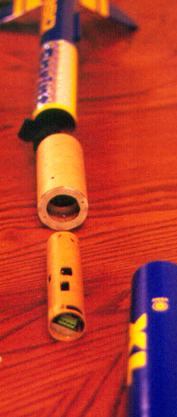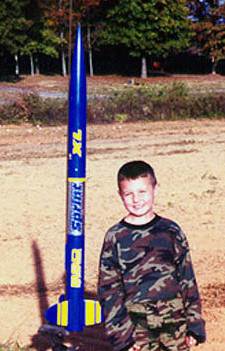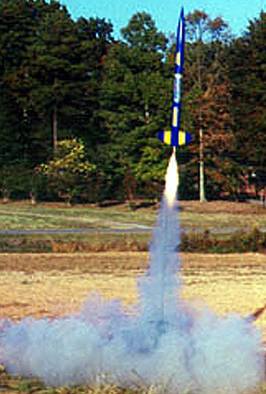BSD High Power Rocketry Sprint XL
BSD High Power Rocketry - Sprint XL {Kit}
Contributed by Roger McMinn
| Manufacturer: | BSD High Power Rocketry  |

(Contributed - by Roger D. McMinn - 11/25/00)
 Brief:
Brief:
BSD Rocketry's Sprint XL is a budget-priced mid to high power design with
elliptical fins and a 10" payload section. I used the payload section to
house a Missile Works RRC2 altimeter for altitude verification and possible
future use as a redundant recovery device.
Construction:
I ordered my Sprint XL from Lawndart Rocketry and received the kit in 5
business days packaged as a box within a box. There was no damage to any of the
components and everything was there. The airframe is two standard 2.6"
glassine tubes. The booster section was pre-marked for the launch lugs and
fins. The Centering rings and bulk-plate are masonite and the three elliptical
fins are 1/4" plywood (the fins were listed on the parts list and BSD's
website as 3/16", but my kit arrived with 1/4" fins). The recovery
system includes a 30" white parachute, a nylon shock cord strap, and 10'
of 1" wide elastic shock cord. The kit also included a nice eyebolt
assembly and very nice vinyl graphic decals.
The illustrated 8-page instruction manual is by far the most comprehensive I have yet to see for a MPR rocket and would be useful to even the newest rocketeer. I followed the instructions for the most part except when it came to attaching the nylon shock cord strap to the airframe tube; I attached mine to the motor mount PML-style as I found this easier to accomplish. Also, I used tubular Nomex® around the shock cord to protect the cord and 'chute.
As mentioned earlier, the airframe comes marked for fin installation but does not come pre-cut for the fin slots. Cutting the fin slots for the through-wall construction might be a little daunting for the newbie, but really wasn't too difficult with a sharp razor knife. A fin alignment guide is included with the kit and I found it to be helpful when epoxying the fins on.
Speaking of the fins: They were pre-cut but need to be beveled or rounded before installation. The instructions suggest a belt sander and I tried this, but due to the elliptical shape I had better results with the drum sander on my Dremel tool.
A single 1/4" launch lug is used to guide the rocket up the launch rod.
 The fit of all the components was good and
required minimal sanding to produce a sturdy little rocket. I deviated from the
instructions a little on the payload section in that I fabricated two centering
rings and an extra bulk-plate to contain my RRC2 (which is mounted in a 38mm
motor mount tube). I also attached the payload airframe tube to the coupler
with PML removable rivets to provide easy access to the altimeter (see photo).
I friction fit the nosecone with a few wraps of masking tape. I would rate the
construction as a 4.5, with the 1/2 point being that the fins I received were a
little thicker than advertised.
The fit of all the components was good and
required minimal sanding to produce a sturdy little rocket. I deviated from the
instructions a little on the payload section in that I fabricated two centering
rings and an extra bulk-plate to contain my RRC2 (which is mounted in a 38mm
motor mount tube). I also attached the payload airframe tube to the coupler
with PML removable rivets to provide easy access to the altimeter (see photo).
I friction fit the nosecone with a few wraps of masking tape. I would rate the
construction as a 4.5, with the 1/2 point being that the fins I received were a
little thicker than advertised.
Finishing:
The rocket arrived on Tuesday and I was bound-and-determined to fly on Sunday,
so I didn't get to dote over the finish like I usually do. I applied coat of
sandable primer Saturday afternoon, and actually applied the blue color coat in
near darkness Saturday evening. The Krylon paint dried very fast and I
hesitated about putting the beautiful decals on so soon after painting, but I
couldn't resist. After letting the paint dry a few hours I applied the vinyl
decals later that night. These are definitely the best decals I have ever used
and I congratulate BSD Rocketry for setting a standard all kit manufacturers
should follow on these. They really make the rocket look great. BSD Rocketry
gets a 5 from me on the finishing components and instructions.
Construction Rating: 4 out of 5
 Flight:
Flight:
Well, Sunday came and I loaded an Aerotech F52-5 reload into the Sprint XL. The
instructions recommend anything between a F50 and a H180. One thing the
instructions leave out, however, is the CP and estimated weight of the rocket.
My rocket was going to fly with the RRC2 in the nose, and had the added drag of
the 1/4" fins, so I wasn't too worried about stability being a problem. It
would have been nice to have this data, though. Anyway, the Sprint XL launched
nice and straight on the F-52 and deployed just past apogee for a perfect first
flight. The RRC2 indicated 582'. The only problem was the rocket nearly landed
on a fellow rocketeer's brand new (1 day old) Ford Explorer. Luckily (I guess),
it just missed his car and landed on the hood of my car. No damage to the
rocket but a little blue paint was left on my old Honda.
Second flight on this rocket was using a G64-7 reload and was picture perfect. Deployment was right at apogee after a straight boost to 1280'. The rocket landed within 60' of the launch rod and was recovered without a scratch.
 I'm looking forward to shooting the Sprint
XL again this weekend, though the H180 will have to wait until my next trip to
Orangeburg.
I'm looking forward to shooting the Sprint
XL again this weekend, though the H180 will have to wait until my next trip to
Orangeburg.
Recovery:
Even with the extra 6oz or so of the Missile Works altimeter the 30 inch
parachute brought the Sprint XL back to earth gently enough that you can hardly
tell it's been flown, even after bouncing off of my car! The Nomex® shock cord
protector did it's job and both the shock cord and parachute were in perfect
condition.
Flight Rating: 4 out of 5
Summary:
I must say that I am very pleased with both BSD Rocketry's product. The Sprint
XL is a nice rocket that allows a payload to be flown utilizing consumer motors
and is seems durable enough to be flown on H-motors. The decals and
instructions sent with the kit are unbeatable in my experience. I was also
pleasantly surprised to find that my kit included the motor retention hardware
even though it was announced after I ordered my rocket. If there are any cons,
it would only be lack of CP data and that my fins were not quite to
specifications. These are minor points though, and I would highly recommend the
Sprint XL to anyone looking for good-looking and good flying rocket.
Overall Rating: 4 out of 5
 |
 |
Flights
 |
 |